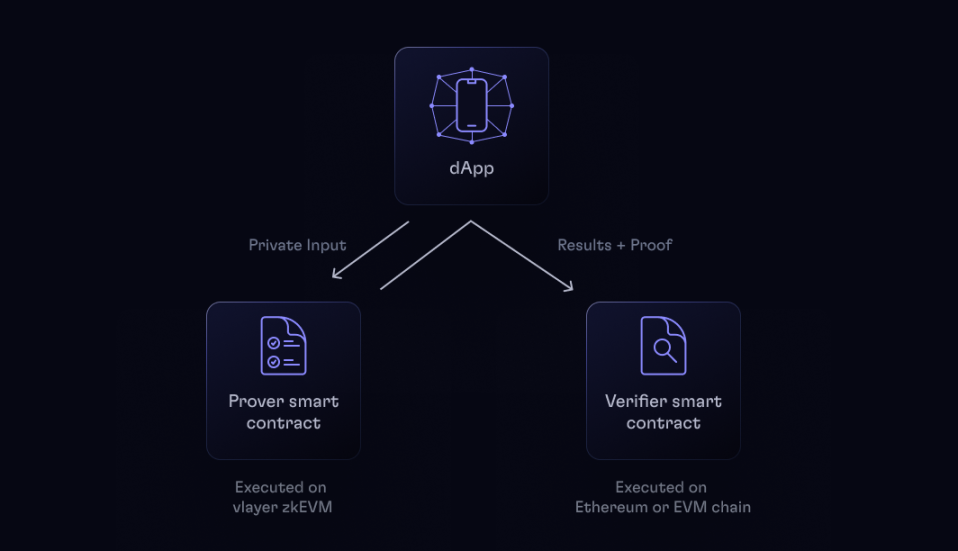Building "Verifiable Data Infrastructure," Innovating "Solidity 2.0"
Written by: Pzai, Foresight News
The communication of on-chain and off-chain data is key to bridging the gap between the two major economic systems. Currently, many solutions focus on the transmission of data such as asset prices and event outcomes, facing certain limitations in multi-chain interactions and broader internet interaction paradigms.
Vlayer, as a project selected in the crypto startup accelerator (CSX) list announced by a16z in September, recently raised $10 million in seed funding. Investors in this round include a16z CSX, Credo Ventures, and BlockTower Capital, along with investors such as Remco Bloemen from World (formerly Worldcoin), Jakub Florkiewicz from Tools For Humanity, and Zac Williamson, Joe Andrews, and Kev Wedderburn from Aztec.
Since 2023, Vlayer has been dedicated to building a "Verifiable Data Infrastructure," which it refers to as "Solidity 2.0," providing Ethereum developers with the ability to verify and integrate off-chain data within smart contracts through zero-knowledge proofs. Hubert Rachwalski von Rejchwald, co-founder and CEO of Vlayer, stated, "We provide direct access to additional verifiable data sources from Solidity code, meaning zero-knowledge proofs will ultimately become a product that any Solidity smart contract developer is familiar with and can easily use." This article dissects its technical architecture and explores how it further integrates relevant data.
Infrastructure
Vlayer introduces two new contract types: Prover and Verifier. The Prover code runs on an off-chain zkEVM, proving the results of corresponding data structures. The Verifier validates the generated proof and runs code on EVM-compatible chains. Accordingly, applications can perform private inputs and then execute on-chain using the results and proofs generated by the Prover.

Features
Vlayer introduces several features in off-chain zkEVM execution, including data retrieval from specific blocks ("time travel"), cross-chain contract interactions (Teleport), and off-chain data verification based on zkTLS.
On-Chain Data
For on-chain smart contracts, they can only access the state of a single block, while "time travel" allows for EVM state interactions across specific blocks or even multiple block intervals. The deterministic backtracking of historical data can help achieve various on-chain functionalities, such as token holding duration and averages, emission conditions, and changes in borrowing and liquidation scales.
For EVM-compatible chains, multi-chain data calls can also be achieved through Teleport's multi-chain call (setChainId). This feature allows for the minting of tokens after verification using data held across multiple chains on a specific chain.
These features complement the interoperability bottlenecks caused by the differing on-chain environments of Solidity itself. However, for some chains, the finality asynchrony caused by their verification mechanisms may impact the immutability of the data itself, so it is recommended that developers prioritize using blocks with finality confirmation.
Off-Chain Data
As an important component of internet interaction, how user interactions on traditional internet applications integrate into the on-chain economic system has been a long-standing topic for countless projects. Now, zkTLS technology (network proof) can bridge this critical point, as it can prove the authenticity of data from any server.
Unlike directly obtaining data through APIs, many traditional application APIs are relatively closed, while zkTLS allows users to access website data directly without permission. Vlayer introduces this technology into on-chain smart contract execution to bring trusted off-chain interaction data on-chain, undoubtedly opening the door for large-scale applications. Additionally, Vlayer can generate relevant proofs for emails.
This technology can be applied to the following use cases:
- Automatically minting corresponding fan tokens based on listening counts from music software (or support counts for fan activities)
- Automated incentive processes (e.g., providing corresponding incentives based on the number of Twitter posts)
- Execution of AI Agents (e.g., synchronizing off-chain operations with on-chain actions)
Conclusion
The eve of Mass Adoption requires countless roads to be paved. Vlayer, by introducing zkTLS technology, has built a trusted data bridge between blockchain and traditional internet, allowing off-chain data to be verifiably brought into the on-chain world. Its technological vision is reflected in multiple specific application scenarios.
The project is currently in an open alpha phase, recruiting early developers in the DeFi, RWA, and gaming sectors for testing and development. Its testnet, mainnet, and tokens are expected to launch in 2025 and beyond. For developers, this is also an opportunity to participate in early construction. As the gap between on-chain and off-chain continues to be bridged, we hope to welcome true applications in a deterministic future.
免责声明:本文章仅代表作者个人观点,不代表本平台的立场和观点。本文章仅供信息分享,不构成对任何人的任何投资建议。用户与作者之间的任何争议,与本平台无关。如网页中刊载的文章或图片涉及侵权,请提供相关的权利证明和身份证明发送邮件到support@aicoin.com,本平台相关工作人员将会进行核查。




